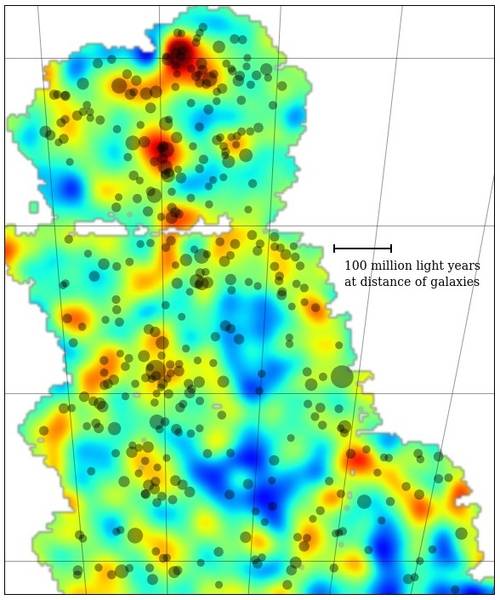13.04.2015
First detailed guide to spotting dark matter
Scientists on the Dark Energy Survey have released the first in a series of dark matter maps of the cosmos. These maps, created with one of the world’s most powerful digital cameras, are the largest contiguous maps created at this level of detail and will improve our understanding of dark matter’s role in the formation of galaxies. Analysis of the clumpiness of the dark matter in the maps will also allow scientists to probe the nature of the mysterious dark energy, believed to be causing the expansion of the universe to speed up. Scientists of the Excellence Cluster Universe are participating in the international Dark Energy Survey Collaboration.
Dark matter, the mysterious substance that makes up roughly a quarter of the universe, is invisible to even the most sensitive astronomical instruments because it does not emit or block light. But its effects can be seen by studying a phenomenon called gravitational lensing – the distortion that occurs when the gravitational pull of dark matter bends light around distant galaxies. Understanding the role of dark matter is part of the research program to quantify the role of dark energy, which is the ultimate goal of the survey. The Dark Energy Survey is a collaboration of more than 300 scientists from 25 institutions in six countries.
The scientists worked for more than a year to carefully validate the lensing maps. “We measured the barely perceptible distortions in the shapes of about two million galaxies to construct these new maps,” says Prof. Jochen Weller, from the University Observatory of the Ludwig-Maximilians-University Munich and member of the DES collaboration. “ The new map was created using data captured by the Dark Energy Camera, a 570-megapixel imaging device that is the primary instrument for the Dark Energy Survey (DES). The camera is mounted on the 4-meter Victor M. Blanco telescope at the National Optical Astronomy Observatory’s Cerro Tololo Inter-American Observatory in Chile. The maps are a testament not only to the sensitivity of the Dark Energy Camera, but also to the rigorous work by our lensing team to understand its sensitivity so well that we can get exacting results from it.”
The dark matter maps make use of early DES observations and cover only about three percent of the area of sky DES will document over its five-year mission. The survey has just completed its second year. As scientists expand their search, they will be able to better test current cosmological theories by comparing the amounts of dark and visible matter.
Those theories suggest that, since there is much more dark matter in the universe than visible matter, galaxies will form where large concentrations of dark matter (and hence stronger gravity) are present. So far, the DES analysis backs this up: The maps show large filaments of matter along which visible galaxies and galaxy clusters lie and cosmic voids where very few galaxies reside. Follow-up studies of some of the enormous filaments and voids, and the enormous volume of data, collected throughout the survey will reveal more about this interplay of mass and light.
“Our analysis so far is in line with what the current picture of the universe predicts,” Chang said. “Zooming into the maps, we have measured how dark matter envelops galaxies of different types, and how together they evolve over cosmic time. We are eager to use the new data coming in to make much stricter tests of theoretical models.”
Original publication:
Vikram et al.: Wide-Field Lensing Mass Maps from DES Science Verification Data (2015)
Contact:
Prof. Dr. Jochen Weller
University Observatory Munich
Ludwig-Maximilians-Universität
Scheinerstraße 1
D-81679 München
E-Mail: jochen.weller@usm.lmu.de
Tel.: +49.89.2180-5976
Dr. Jörg Dietrich
University Observatory Munich
Ludwig-Maximilians-Universität
Scheinerstraße 1
D-81679 München
E-Mail: dietrich@usm.lmu.de
Tel. +49.2180-5942
Press contact:
Petra Riedel
PR Manager
Exzellenzcluster Universe
Boltzmannstraße 2
D-85748 Garching
E-Mail: petra.riedel@universe-cluster.de
Tel.: +49.89.35831-7105






